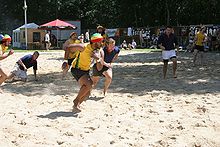Beach rugby
Beach rugby is a sport of the rugby family . Although there are centrally established rules of the IRB , no set of rules is used uniformly, especially because there is a dispute about whether beach rugby should be played based on rugby union or rugby league . Beach rugby is played in tournaments and competitions across Europe . What all competitions have in common is that the playing fields are much smaller than normal rugby playing fields, that far fewer players take part and the point system is simplified. With different rules, beach rugby is often practiced as a leisure and recreational sport around the world. Beach rugby is available for men as well as women and children.
regulate
Despite the rules of the IRB, a separate set of rules is currently being drawn up for the European tournaments.
Rules based on Rugby League
matchfield
The usual field length is between thirty and fifty meters and twenty to 35 meters wide; the painting fields are three to seven meters deep. There are no gate poles and the lines of the field are usually laid out with ribbon or rope.
Duration of the game
A game lasts two halves between five and seven minutes with a one to three minute break. An extension can be added depending on local competition rules.
number of players
Depending on the size of the field, a team consists of five to seven players. Three to seven substitutes can usually be substituted on during the game.
Play device
The play equipment is a normal rugby ball , but often in size 4 instead of the size 5 used in men's rugby. Beach rugby is played in normal rugby pants and jerseys, but without socks and shoes. As with normal rugby, a face mask is mandatory for protection.
Points
Since there are no goal posts, placing the ball in the opponent's in-goal (an " attempt ") is usually scored with one point. Some leagues decide games that are tied at the end of the season with the next attempt ( sudden death ).
An Italian league divides the in-goal into five equal rectangles. Attempts placed in the two outer rectangles count three points, attempts in the middle five and attempts in the two spaces in between count four points. Similar to the official rugby variants, where the raise kick becomes easier the further the ball is placed in the middle, an attempt in the middle of the in-goal is more valuable. However, it is unknown whether this league still exists.
Game flow
The rules of the rugby league are used with some modifications. The offside line is usually kept, but the distance is never more than five meters. After a tackle , the held player must pass or put down the ball within three seconds, otherwise his team will lose possession of the ball. Often a variation of the rugby league rule is applied that after six consecutive tackles the ball changes possession; however, sometimes tackles are not counted and the only way to gain possession is through an opponent's mistake. Some leagues even only play touch or tag rugby and completely forego hard physical contact.
Usually kicking the ball is not allowed; the exception is a quick kick to restart the game.
The typical rugby standard situations of alley and scrum are often replaced by a short kick in beach rugby, and the beginning and restart of the game is also carried out with a short kick. However, the rules often differ from tournament to tournament, in many tournaments both the lane and the scrum are an integral part of the game. Since open scrum and packages are usually not part of the game either, the main focus is on the running and passing game of the two teams.
Tournaments
Large beach rugby tournaments take place regularly in summer. In Europe, the tournaments on Ameland with over 140 participating teams, the invitation tournament in Lignano and the Beach Rugby Tour with 10 stations and a French beach championship organized by the French Rugby Association (FFR) are particularly worth mentioning.
A large beach ruby tournament for men, women, children and mixed teams also takes place regularly in Walferdangen in Luxembourg. In addition to Luxembourgish teams, numerous German teams, especially the women, compete in this tournament.
In Germany tournaments take place in Trier, Bad Köstritz, Saarbrücken and Hamburg. The tournaments are organized by the University of Trier, the Stade Sarrois Saarbrücken, the Eastern Province Rugby Club and the Jesteburg Wombats. The tournament in Hamburg is special because it is held in a hall in winter, traditionally between Christmas and New Years.
See also
swell
- ↑ German translation of the beach rugby rules of the IRB from www.regel.drvreferees.de
- ↑ Proposed rules for European beach rugby tournaments ( Memento of March 14, 2007 in the Internet Archive ) (English) / July 2006

